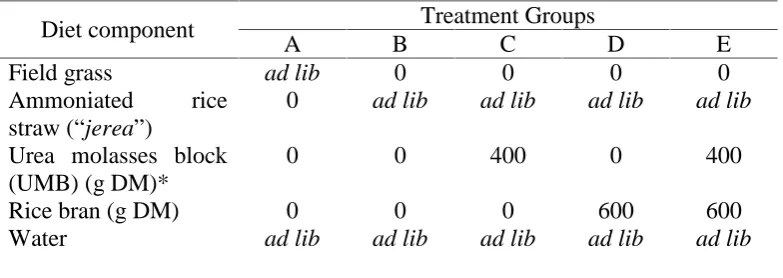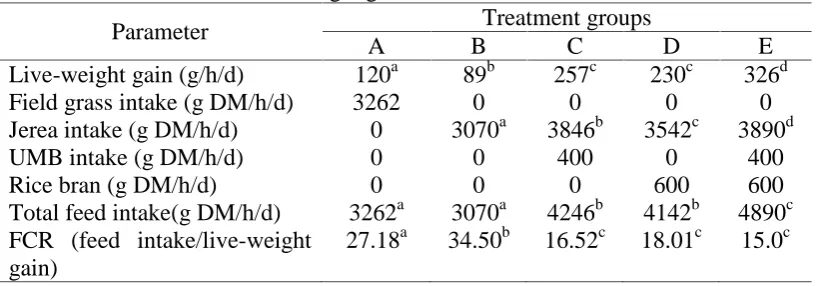1
THE PERFORMANCE OF BALI CATTLE FED ON UREA CONTAINING DIETS
I B. Sudana, N. W. Siti and Dsk. P.M.A. Candrawati [email protected]
Faculty of Animal Husbandry Science Udayana University
______________________________ABSTRACT_________________________
A feeding experiment was conducted in which Bali cattle were given a basal diet of urea ammoniated rice straw supplemented either with urea molasses block, rice bran or urea molasses block plus rice bran. The experiment was designed in completely randomized design (CRD) with 5 treatments and 4 animals in every treatment.
The objective of the experiment was to examine the effects of supplementation on bodyweight gain and the efficiency of feed conversion in Bali cattle, feed on urea ammoniated rice straw basal diets.
Cattle on the supplemented diets produced an average bodyweight gain of 230-326 g/h/d. The highest live weight (326 g/h/d) was observed on cattle given basal diet supplemented with 400 g urea molasses block plus 600 g/h/d of rice bran. The use of urea molasses block as a supplement was superior to rice bran supplement. Although the straw intake of all groups of animals was not significantly different (P>0.05), the supplemented groups used diets more efficiently. The lowest FCR in this experiment was 15.0 observed on cattle given a basal diet of urea ammoniated rice straw, supplemented with 400 g urea molasses block plus 600 g/h/d of rice bran.
__________________________________________________________________
Keywords: Bali cattle, urea ammoniated rice straw, urea molasses block, rice bran supplement
INTRODUCTION
Bali cattle are the only pure-breed cattle in Indonesia. The origin of this breed is Bos banteng.
The Indonesian government is trying to develop this breed intensively at the village level. This reason for this is that this breed is the original one, adapted well to the environment and culture in Indonesia, especially in Bali. Slow growth rates of the Bali cattle have reduced the effectiveness of the government programme.
2
It would be very valuable if the conventional cattle diet in Bali could be improved by a simple treatment or supplementation that is not expensive and easy to manage by the farmer at the village level. The available and cheap feed (rice straw) is highly indigestible and low in N content. The use of urea ammoniated rice straw (Mudita,2008) and urea molasses block or rice bran or the combination of both as a supplement is a good approach (Sudana, 1992;Wanapat and Khampa,2007). Therefore, studies were designed on the use of urea ammoniated rice straw (“jerea”) UMB, and rice bran in increasing the utilization of rice straw in the Bali cattle diet and increasing the performance of the Bali cattle itself.
MATERIAL AND METHODS
After 2 weeks adjustment period, 20 uncastrated Bali cattles (147 –156kg bodyweight) were randomly allocated to 5 experimental diets show in table 1. “Jerea” were made by ammoniated the fresh rice straw with urea (4% urea/straw DM) and fermented in un-aerobic condition for 6 weeks. The urea molasses block (UMB), (which consisted of: 16% urea, 37% molasses, 32% rice bran, 6.5% copra meal, 8% lime and 2% minerals mix) was given to the animals twice a day in a total quantity of 400g/h/d. Rice bran were fed to the animals one a day (600g/h/d). Daily feed intake was recorded and the animals were weight every 2 weeks prior to feeding. The treatment covered 12 weeks. Data were analysis using an analysis of variance (Snedecor, 1968).
Table 1. Composition of the diets
Diet component Treatment Groups
A B C D E
Field grass ad lib 0 0 0 0
Ammoniated rice straw (“jerea”)
0 ad lib ad lib ad lib ad lib
Urea molasses block (UMB) (g DM)*
0 0 400 0 400
Rice bran (g DM) 0 0 0 600 600
Water ad lib ad lib ad lib ad lib ad lib
*Manufactured by sub. BPTP, Grati, East Java- Indonesia
RESULTS AND DISCUSSION
Mean total DM intake, straw intake, rice bran intake, live-weight change and FCR for each group of cattle are given in Table 2.
3
molasses block (Sudana and Leng, 1986). In all studies the first limiting nutrient for microbial growth has been assumed to be ammonia.
Table 2. Feed intake and live-weight gain
Parameter Treatment groups
A B C D E
Live-weight gain (g/h/d) 120a 89b 257c 230c 326d
Field grass intake (g DM/h/d) 3262 0 0 0 0
Jerea intake (g DM/h/d) 0 3070a 3846b 3542c 3890d
UMB intake (g DM/h/d) 0 0 400 0 400
Rice bran (g DM/h/d) 0 0 0 600 600
Total feed intake(g DM/h/d) 3262a 3070a 4246b 4142b 4890c FCR (feed intake/live-weight
gain)
27.18a 34.50b 16.52c 18.01c 15.0c
Value on different alphabet on column showed significant (P<0.05)
The data presented here tend to suggest that the urea molasses block provided some deficient nutrient (s) despite supposedly complete supplementation with minerals including Na, Cu, P, S and trace elements, since the urea molasses block increased straw and total intake as well as live-weight change above that for the basal diet and the diet supplemented with rice bran only. Molasses itself is a concentrated plant juice and as such, contains a wide range of trace minerals, vitamins, sugars (sucrose, glucose and fructose usually about 2:1:1) and is particularly rich in potassium and sulphur. The intake of molasses was about 180 g/h/d only and therefore the additional nutrients must have acted mainly to increase the efficiency of utilization of the feed. Due to the improved rumen conditions, presumably small intestinal protein supply increases, resultantly increasing the proportion of protein deposition relative to fat.
An important practical aspect here is that these studies emphasize the obvious advantage of using molasses block as a “coverall” in the variable and largely unknown feeding system that pertain to animals fed on agro-industrial by products under village conditions in developing countries (Leng, 1984). The urea molasses bock, which has been much for grazing animals (Loosli and Mc.Donald, 1986, Leng et al., 1973, and Bal and Ozturk,2006) is, however, a most effective way to providing urea and of overcoming a number of potential mineral deficiencies and acid or peptides. The approach is now finding application and appears to be a method of choice of providing these nutrients to ruminants in the tethered husbandry system of some developing countries (Sudana and Leng, 1986).
CONCLUSION
4
Even after urea treatment, the treated straw alone is still roughage which provides only sufficient nutriens for maintenance on low production and only converts this diet from a sub maintenance to a little better than a maintenance diet. Urea-ammonia treatment seems to be areliable choice for farmers in developing countries since it is probably more economical and practical than other methods.
To obtain high animal productivity from treated or untreated rice straw (if production is the objectives), rice straw should be supplemented with molasses block, rice bran or the combination of booth, and the use of urea-molasses-block for this purpose appears to be agood approach.
As a source of a supplement to rice straw basal diet, urea molasses block is superior to rice bran because it is contain, mineral, salt and vitamin completely as well as additional energy provided.
UCKNOWLEDGEMENTS
Thank to Apni Tristia Umiarti who typed this article and the Indonesian government for financial support.
REFERENCES
Astawa, I.P.A. 2007. Kecernaan nutrient dan produk fermentasi rumen pada sapi Bali penggemukan yang diberi ransum konsentrat berbasis jerami padi dengan suplementasi vitamin mineral mix. Tesis Program Pasca Sarjana Universitas Udayana, Denpasar.
Bach, A.S. Calsamiglia and M.D. Stern 2005. Nitrogen Metabolism in The Rumen. J. Dairy Sci. 88 ( E. Suppl) : E9-E21. American Dairy Science Association.
Bal, M.A and D. Ozturk. 2006. Effects of Sulfur Containing Supplements on Ruminal Fermentation and Microbial Protein Synthesis. Reseach Journal of Animal and Veterinary Sciences (I) : 33-36. INS I net Publication.
Block, E. 2006. Rumen Microbial Protein Production : Are We Missing An Oppurtunity to Improve Dietary and Economic Efficiencies in Protein Nutrition of The High Producing Dairy Cow Industry Presentation. High Plains Dairy Conference.
5
Leng, R.A., R.M. Murray, J.V. Nolan and B.W. Norton, 1973. Supplementing Grazing Ruminants with Urea-molasses Mixtures. AMRC Reviews, 15: 1-9
Leng, R.A. and J.V. Nolan, 1984. Nitrogen Metabolism in the Rumen. Journal Dairy Science, 67: 1072-1089
Loosli, J.K. and I.W. McDonald, 1986. Non Protein Nitrogen in the Nutrition of Ruminants. FAO Agricultural Studies No. 75, 1-52
Mudita, I.M. 2008. Sintesis protein mikroba rumen sapi Bali yang diberi ransum komplit berbasis jerami padi amoniasi urea dengan suplemntasi multivitamin-mineral. Tesis Program Pasca Sarjana Universitas Udayana Denpasar.
Snedecor, G.W. and W.G. Cochran,1968. Statistical Methods (6thEd.) Lowa State University Press, Ames, Lowa, pp. 258-296.
Rika, I.K., I.M. Nitis and L.R. Humphreys, 1981. Effects of stocking rate on cattle growth, pasture production and coconut yield in Bali. Tropical Grassland, 15 No. 3.
Sudana, I.B.1984. Straw basal diet for growing lambs. Thesis for M.Rur.Sc. Degree at University of New England, Armidale, Australia February 1984.
Sudana, I.B.1992. Urea molasses block supplement for Bali Cattle fed on rice straw basal diets. In “livestock and feed development in the Tropics”.pp. 184-187
Sudana, I.B. and R.A. Leng, 1986. Effects of Supplementing a Wheat Straw Diet with Urea or a Urea Molasses Block and/or Cottonseed Meal on Intake and live-weight Change of Lambs. Animal Feed Science and Technology 16:25-35.

